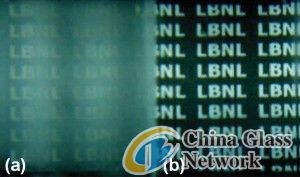Post Time:Jun 23,2011Classify:Glass QuotationView:649
A nanostructured anti-fogging technology for glass developed by the Department of Energy's Lawrence Berkeley Laboratory has been honored with an 2011 R&D 100 award by R&D Magazine. The anti-fogging technology is said to out perform any similar technology on the market.

An LBL photo shows the glass slide that's been placed in a freezer, then exposed to humid air at room temperature. Fog formed on the uncoated portion of the slide (a) while the portion (b) coated with superhydrophilic nanoparticles remained fog free.
The coating consists of nanoparticles made from superhydrophilic titanium dioxide. When applied to glass surfaces, the nanoparticles cause water droplets to collapse and flatten within fractions of a second, officials explain. Water vapor, however, can infiltrate spaces formed by nanoparticle overhangs to dislodge dust and grime from the coated surface. This keeps the glass clean, a big water- saving factor for windows in commercial buildings. It could also be used to improve the efficiency of solar panels in dusty, desert environments, the researchers note.
The invention of the “Nanostructured Antifogging Coating” technology was led by Samuel Mao and Vasileia Zormpa of Berkeley Lab’s Energy and Environmental Technologies Division. The technology is designed to provide a durable, nontoxic, antifogging and self-cleaning coating for architectural glass, windshields, eyewear and solar panels.
“No chemical catalysts or UV radiation are required to activate the coating so therefore it works at night,” notes Mao, who directs the Clean Energy Laboratory for EETD. “Also, because the coating is non-toxic, unlike some of its competitors, it can be used on dental mirrors and food wrap in refrigerated displays.”
Source: http://www.windowanddoor.com/news-item/noteworthy/Author: shangyi